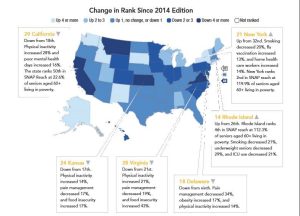 By Alyssa Scott
By Alyssa Scott
KU Statehouse Wire Service
TOPEKA – Handcuffs, leg irons, belly chains — in most Kansas jurisdictions, full shackles are used for every juvenile offender who comes to court from juvenile detention centers, regardless of the offense.
According to Benet Magnuson, executive director of Kansas Appleseed Center for Law and Justice, of the more than 300 youth incarcerated in the state’s two secure juvenile facilities, 40 percent have not committed a crime against people.
“Kansas Appleseed started taking a look at juvenile justice reforms in Kansas following a 2012 legislative post audit of the juvenile prison in Topeka,” Magnuson said. “What we found was that a lot of the kids at that facility were there for non-persona offenses, so they had been adjudicated for things like drug and property crimes. Fifteen percent of the kids who walk through the door in a given year were there for misdemeanors only.”
These inappropriate placements in the juvenile justice system have negative effects not just on the youth, but also on the economy. According to a testimony Magnuson prepared for the Kansas House earlier this year, it costs $243 per day to keep a youth in a secure juvenile facility and it costs $133 per day for out-of-home placements. Kansas spends $27 million on its two secure juvenile facilities and $31 million on out-of-home placements, which are typically residential centers for youth in the custody of the state juvenile authority. Josh Weber, program director for juvenile justice at the CSG Justice Center, said Kansas is moving toward utilizing criteria that would reduce these costs.
“One of the potential benefits of Kansas really trying to put this more consistent objective criteria in place is that you can divert more of those youth to effective community-based services for a fraction of the cost of putting them in residential placement and with those effective services, you can also reduce recidivism rates and re-incarceration rates in both the juvenile and adult system,” Weber said.
The economy isn’t the only area experiencing negative effects from the juvenile justice system. Magnuson said in out-of-home placement centers, 80 percent of the youth are low- to moderate-risk on the Youth Level Service scale and research shows they are not benefitting from the placement.
“Even if we put a pretty low bar for success and define it basically as just not getting kicked out of your program, still the majority of kids fail at these out-of-home placements,” Magnuson said. “Right now, we’ve got a lot of kids going into these placements and they don’t have the resources or regulations to offer meaningful programming and services for these kids.”
Since a large amount of youth offenders are being assigned to out-of-home placements for misdemeanors, Magnuson said they only stay for a few weeks or months, so there is no time to educate them and provide services that will make a positive change in their lives. According to a report from the Council of State Governments, about 30 percent of youth placed in juvenile correctional facilities stay no longer than six months, and this statistic increases to more than 80 percent for those in youth residential centers.
Nina Salomon, senior policy analyst at the CSG Justice Center, said using specialized services to educate youth in the juvenile justice system is a key part of improving their long-term outcomes.
“We have to be really sure that the placement is appropriate and that it provides the services and addresses the needs of that particular youth, whether it’s mental health or substance use or behavioral therapy or anger management, whatever the case may be,” Salomon said. “It’s really important to make sure that a placement has those services and really matches those needs of the kids and also matches the level of offense.”
When youth are improperly placed and end up staying in juvenile facilities for short durations, Salomon said they experience higher recidivism, poor health outcomes and negative academic results. All contribute to overall lower lifetime earnings, Salomon said.
The CSG report for Kansas showed high recidivism rates, which indicate the likelihood that an offender will be a repeat offender. Thirty percent of youth in case management are re-incarcerated in juvenile or adult systems within a three-year period, and for youth in secure juvenile correctional facilities the rate is 42 percent.
Community-based services are an alternative to secure facilities and out-of-home placements. According to Magnuson’s testimony, it costs $16 per day to put a youth under probation within the community. Currently, Kansas spends only $25 million on all types of juvenile justice programs within communities, which include intensive supervision probation, case management and prevention. Magnuson said the state should invest in this area and keep low-risk youth in their communities instead of state facilities.
“I think the research would say, and hopefully this is the direction Kansas is moving, is that we pull low-risk kids out of the system completely, that we reduce the length of stay for kids who are in the facility, and that we take the resources and money that we were wasting on locking those kids up for years on end without any effect and invest it in really meaningful programs,” Magnuson said.
The Kansas legislature started making this change with House Bill 2588, which went into effect last July and established an alternative procedure for adjudication of juvenile misdemeanors. Weber said in order to reform the system completely, the state will have to create consistent criteria to use when placing youth offenders.
“Right now, one of the challenges is that there isn’t any consistent criteria across Kansas,” Weber said. “I think there was some recent legislation that was passed that requires court services to use risk assessments and to make sure that those results are reported to the court, so that’s a great first step.”
When Weber presented his report at a joint House and Senate Corrections Committees meeting in March, Rep. John Rubin (R-Shawnee) said it could push legislature to consider a comprehensive reform bill in the 2016 session. Magnuson said the government needs to continue working to find a solution because youth offenders are at such a critical point in their lives.
“Kids in general are some of the most potentially vulnerable people in our state, and then of all the kids in our state, some of the ones who are just exceptionally vulnerable are ones that are in the juvenile justice system,” Magnuson said. “If Kansas wants to catch up to the rest of the country, we’re going to have to make some pretty broad and serious reforms.”
Alyssa Scott is a University of Kansas junior from Wichita majoring in journalism and French.

















